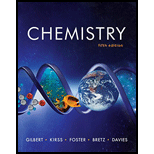
(a)
Interpretation: The given systems are to be categorized as isolated or not isolated and the processes are to be categorized as spontaneous or non spontaneous.
Concept introduction: Spontaneous processes are those processes which start itself without external source of energy. It is a self driven process.
Non spontaneous processes are those processes which requires external source of energy to proceeds the process.
Isolated systems are those systems in which there is no interaction with other systems and here is no exchange of energy and mass.
Non-isolated are those systems which interacts with other systems and there is exchange of energy and mass.
To determine: If a photovoltaic cell in a solar panel producing electricity is an isolated or not isolated system and if this process is spontaneous or non spontaneous.
(b)
To determine: If helium gas escaping from a latex party balloon is an isolated or not isolated system and if this process is spontaneous or non spontaneous.
(c)
To determine: If a sample of pitchblende (uranium ore) emitting alpha particles is an isolated or not isolated system and if this process is spontaneous or non spontaneous.
Want to see the full answer?
Check out a sample textbook solution
Chapter 17 Solutions
Chemistry: The Science in Context (Fifth Edition)
 ChemistryChemistryISBN:9781305957404Author:Steven S. Zumdahl, Susan A. Zumdahl, Donald J. DeCostePublisher:Cengage Learning
ChemistryChemistryISBN:9781305957404Author:Steven S. Zumdahl, Susan A. Zumdahl, Donald J. DeCostePublisher:Cengage Learning ChemistryChemistryISBN:9781259911156Author:Raymond Chang Dr., Jason Overby ProfessorPublisher:McGraw-Hill Education
ChemistryChemistryISBN:9781259911156Author:Raymond Chang Dr., Jason Overby ProfessorPublisher:McGraw-Hill Education Principles of Instrumental AnalysisChemistryISBN:9781305577213Author:Douglas A. Skoog, F. James Holler, Stanley R. CrouchPublisher:Cengage Learning
Principles of Instrumental AnalysisChemistryISBN:9781305577213Author:Douglas A. Skoog, F. James Holler, Stanley R. CrouchPublisher:Cengage Learning Organic ChemistryChemistryISBN:9780078021558Author:Janice Gorzynski Smith Dr.Publisher:McGraw-Hill Education
Organic ChemistryChemistryISBN:9780078021558Author:Janice Gorzynski Smith Dr.Publisher:McGraw-Hill Education Chemistry: Principles and ReactionsChemistryISBN:9781305079373Author:William L. Masterton, Cecile N. HurleyPublisher:Cengage Learning
Chemistry: Principles and ReactionsChemistryISBN:9781305079373Author:William L. Masterton, Cecile N. HurleyPublisher:Cengage Learning Elementary Principles of Chemical Processes, Bind...ChemistryISBN:9781118431221Author:Richard M. Felder, Ronald W. Rousseau, Lisa G. BullardPublisher:WILEY
Elementary Principles of Chemical Processes, Bind...ChemistryISBN:9781118431221Author:Richard M. Felder, Ronald W. Rousseau, Lisa G. BullardPublisher:WILEY





